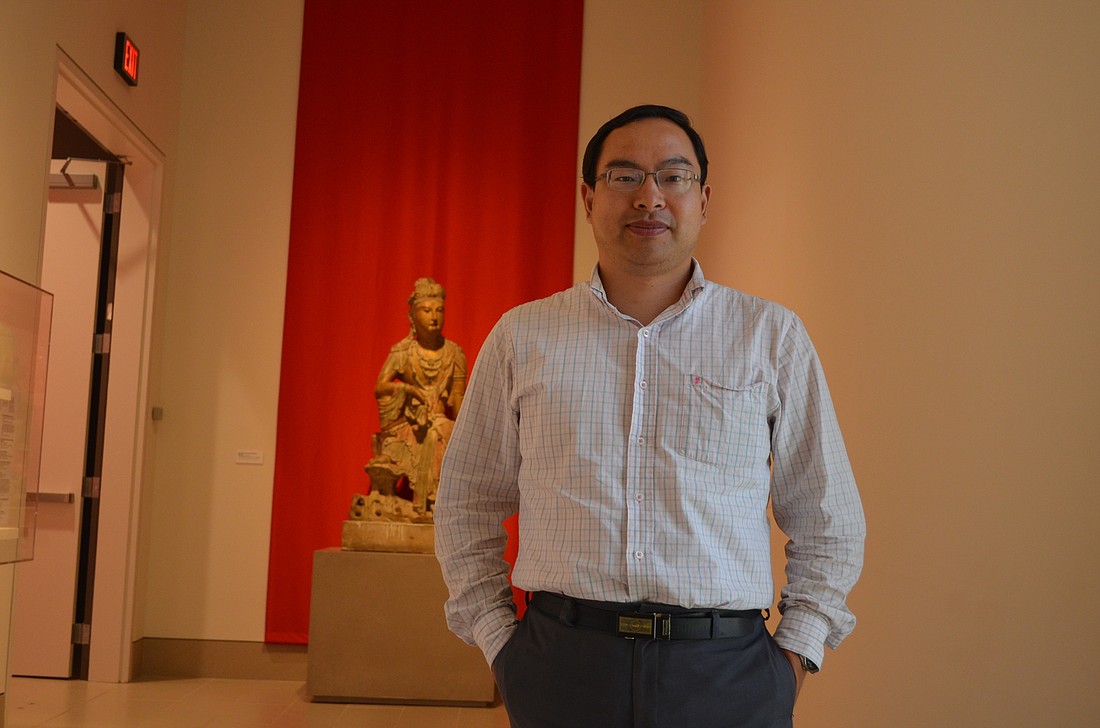- November 24, 2024
-
-
Loading

Loading

At the end of a long hallway in The Ringling’s new Center for Asian Art in the Dr. Helga Wall-Apelt Gallery of Asian Art sits a Buddhist statue from 10th century China.
The stone figure is seated, its gaze calmly transfixed on the opposing end of the corridor, where the Greek Baroque sculpture of Lacoön and His Sons depicts a quite different scene: the Trojan priest and his sons are being attacked by sea serpents.
There’s something of a conversation going on between the two. On one end, the stoic Buddhist statue represents a bodhisattva — a person dedicated to achieving buddhahood for the benefit of all sentient beings. Lacoön, on the other hand, is an iconic representation of human agony.
More than that, though, the juxtaposition represents a geographic and cultural shift for The John and Mable Ringling Museum of Art. Traditionally known for its Baroque and Renaissance art, the museum’s new Center for Asian Art marks its dedication to a global vision — and a fulfillment of John Ringling’s original vision.
“The Ringling is not only dedicated to European art,” says Fan Zhang, the center’s curator. “We’re dedicated to showing off the talents of artists from all parts of the world. This new center is all about connecting cultures.”
A THOUGHTFUL ARRANGEMENT
Zhang is standing in the aforementioned corridor of the recently opened center, which is 25,000 square feet in total, explaining the carefully thought-out arrangement of the exhibits — almost a work of art in itself.
This hallway, he explains, is symbolic of the evolution of Asian art and culture, as influenced by The Silk Road and other international trade, which introduced Western influence and materials. Europe is on one end; China on the other, and a timeline of pottery, sculpture and drinkware lies in between.
The separate gallery spaces are a narrative, choose-your-own-ending exploration of Asian art, culture and history, with metaphors and thoughtful placement throughout.
Starting in the Ting Tsung and Wei Fong Chao Foundation Gallery, visitors can see some of the oldest works, with ancient pieces from India, Vietnam, Pakistan, Japan and China, including pieces from John Ringling’s original collection.
“These over-door phoenix panels were acquired by John Ringling in the 1920s,” says Zhang, pointing to two ornate hangings. “A lot of people don’t realize that John Ringling had a collection of Asian art. With the Great Depression, he was unable to complete his collection, or start an art college or museum. To be able to celebrate his legend and fulfill his vision makes this all the more meaningful.”
The artistic timeline continues, taking a sharp turn toward the contemporary. On display in the third gallery space is a collection modern pieces, represented by two facing stones: one natural, one artificial, made from reflective industrial materials to show the shift in cultural attitudes toward nature, materials and tradition.
“Here,” says Zhang, “is a very different Asia.”
A VISION REALIZED
The center has been a long time in the making. The $11.5 million pavilion has been in the works since 2006, but delays ensued, due to the economic recession and a lawsuit by namesake donor Dr. Helga Wall-Apelt.
After breaking ground in 2013, the center was under construction for two years, and the last year was spent installing the 1,300 pieces from the museum’s permanent collection, in addition to the more than 400 pieces on loan.
For Director Steven High, seeing the years of work come to fruition is only part of the reward.
“This brings in an entirely new dynamic for us,” says High. “We’ve been primarily known as a European institution, but this opens the door to something completely new. And being able to fulfill John Ringling’s original vision means a lot.”
Zhang says he’s looking forward to broadening people’s horizons. For him, the Center for Asian Art is a chance to enhance people’s understanding of different cultures around the world trough the universal language of art.
“We want to instill a global vision,” he says. “In our visitors, in students, in other artists. When I see audiences gathered in front of these pieces, learning about world history and culture — that’s an amazing moment for me.”